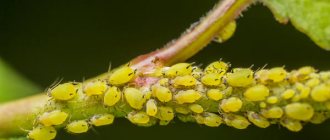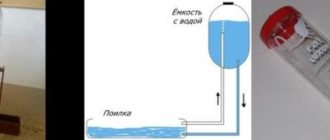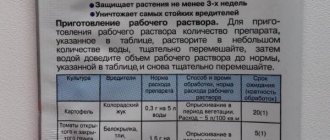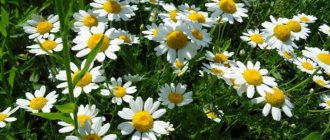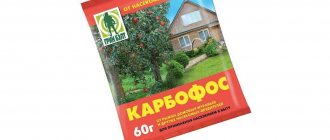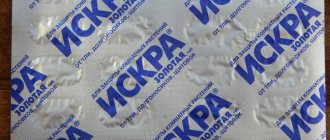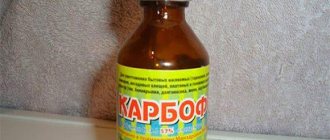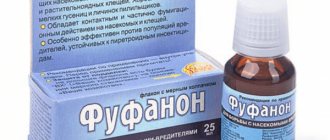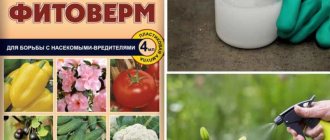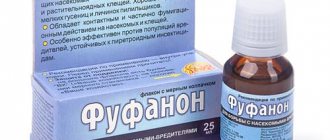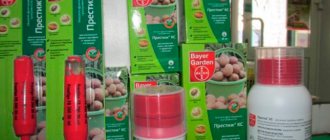Application
Green soap is used in its pure form, diluted with water, or as an adhesive in solutions where an alkaline reaction is acceptable (the pH of the solution is from 7 to 8), or in a mixture with other agents (infusions of herbs, tobacco, etc.).
How to dilute green soap against pests:
- against aphids and mites 200-400 g of green soap per 10 l
- against scale insects 200-300 g of green soap per 10 l
- against aphids 200-400 g of green soap per 10 l
To combat bedbugs, green soap is used as part of a complex solution: 4 parts potassium soap, 1 part turpentine, 2 parts kerosene and 12 parts water.
For indoor flowers, the recipe is simple: dissolve 1 tablespoon of green soap in 1 liter of warm water. If a measuring cup is included, use it as directed.
Features of the drug
The effect of soap on insects and arthropods (ticks) is to envelop the body with a film and block the respiratory tract.
Green soap can be mixed with other insecticides, in particular with decis, karbofos, intavir, at the rate of 40-100 g per 10 liters of water; soap, in addition to its main properties (toxicity to pests), gives the pesticide solution better stickiness, i.e. the solution forms a more stable film over the surface of the sheet.
For the same reason, green soap is often used in combination with fungicides against a number of plant diseases, for example, powdery mildew, rust, and fungal spotting. Usually the main component is some kind of copper-containing preparation, for example, copper sulfate. To prepare 1 liter of solution, pour exactly 800 g of warm water into a 1-liter jar, add 30 g of green soap and mix. In another jar, 2 g of copper sulfate is dissolved in 200 g of warm water. Then slowly (in a thin stream) with continuous stirring with a wooden stick, pour the vitriol solution into the soap solution. This solution is sprayed on the plants leaf by leaf against fungal infections.
Gardeners often use a solution of green soap against powdery mildew and other diseases, in combination with soda ash. In this case, take 50-100 g of soap and 50 g of soda per 10 liters of water.
Another effective recipe for ticks: 20 g of ground dried garlic (40-50 g of fresh garlic), 200 g of green soap, diluted with water to 10 liters of water. If the garlic is fresh, you need to crush it in a mortar, if dry, steam it in a small amount of boiling water.
No more than 3 applications per season are allowed with green soap. Process for the last time no later than 5 days before harvest.
Toxicity
Green soap has a hazard class of 4 (low hazardous substance). Not phytotoxic. Practically non-toxic for birds, earthworms, soil microorganisms and bees (the border protection summer zone for bees is at least 3 - 4 km, the flight limit for bees is 48 - 72 hours).
Fruit or berry trees and shrubs can be processed at least five days before harvest. If green soap is not used in its pure form, but with the addition of other pesticides or turpentine, then treatments are carried out before flowering, or after harvesting, no later than 30 days before harvesting.
Security measures. Handle using gloves. While working, you must not smoke, drink, or eat. Dilute the working fluid solution exclusively in glass or porcelain containers. Do not use dishes that have come into contact with alkali for household purposes or cooking. Store the drug in a cool, dry room at a temperature from -10C to +35C, separate from food and medicine, out of the reach of children and pets! Storage of the working solution is not allowed. The shelf life of green soap is 1-2 years (see on the package).
First aid for poisoning: if the drug gets on the skin, rinse with plenty of water, to neutralize the alkali, apply a gauze bandage soaked in a 5% acetic acid solution to the affected area after rinsing (for 10 minutes). After removing the bandage, rinse the skin with water. In case of contact with eyes, rinse thoroughly with running water for 15-20 minutes. Then rinse the eyes with a 2% solution of boric acid and drip albucid. Do not hesitate to consult an ophthalmologist. If ingested, drink 3-4 glasses of water, induce vomiting, take several tablets of activated charcoal, and seek immediate medical attention.
How does green soap work on aphids?
The drug gets on the surface of the leaves and stems and creates a thin film. It is under it that pests find themselves. They suffocate due to lack of air and die. At the same time, insects cannot leave the dangerous place due to the strength of the film. Gardeners use green soap against aphids and ants, as well as a number of other common pests:
- slobber;
- herbivorous bugs;
- scale insects;
- thrips.
The product is produced in plastic bottles of different sizes - 250, 500 and 900 ml. Containers can only be stored at positive temperatures in the range from 7 to 40 degrees. Keep away from direct sunlight and keep out of reach of children. The shelf life is three years from the date of production. It is not advisable to store the drug at subzero temperatures.
Green soap allows you to destroy aphids and other dangerous pests
Composition of Green Soap and effects on pests
Green soap, also called potassium soap, is obtained by treating cattle fats or vegetable oils with potassium hydroxide. As a result of the chemical reaction, a greenish soap emulsion is formed, which easily dissolves in water. The main active ingredient of this drug is potassium salts of fatty acids.
Green soap is an environmentally friendly product for protecting plants from pests and diseases
Green soap is an environmentally friendly product, harmless to people and pets if you follow simple precautions:
- Storage in tightly closed containers, out of reach of children and animals.
- Work with gloves, goggles and a respirator or gauze bandage.
- Personal hygiene after spraying plants.
This drug is classified as the fourth group of harmful substances in terms of the degree of impact on the human body.
Interstate safety classes of substances for humans
Which hazard group a chemical compound belongs to is determined by the dose that causes death. Group 4 includes those substances that will become fatal if you swallow 50 grams or more per kilogram of weight.
In plant growing, green soap is used to control pests:
- aphids;
- thrips;
- slobbering penny;
- leafhoppers;
- earwigs;
- scale insects;
- spider mites.
Photo gallery: pests that Green soap can handle
The film that forms on the surface of plants after treatment with a solution of the drug has several consequences for pests. The most important thing is the destruction of the chitinous cover. In addition, they can no longer:
- breathe;
- move;
- eat.
Advantages and disadvantages of green soap
The main advantages of this type of soap include:
- the product dissolves easily in water;
- is an environmentally friendly product;
- complete absence of preservatives;
- low toxicity (class 4) for humans and warm-blooded animals;
- in the doses specified in the instructions, the drug is practically harmless to cultivated plants and the environment;
- the product does not cause allergies;
- compatibility of green soap with most fungicidal and insecticidal preparations.
There are no particular negative qualities noted in green soap.
Green soap + fungicides
Instructions for use
To dilute the drug, it is better to use soft water with a low salt content. Shake the container with the drug, combine the product with water, determining the proportions depending on the purpose (instructions for using green soap are indicated on the container with it). The drug must be diluted in water thoroughly until completely dissolved. For processing - spraying or manual soaping - choose morning or evening time, the weather is dry and calm.
Pest control requires the use of the drug in the following proportions:
- against aphids - add 200-400 ml of green soap to 10 liters of water. Spray during the growing season 1-3 times a day, ending treatments five days before the first harvest;
- against thrips - 100 ml of soap is enough for the same volume of water;
- for scale insects - add 200-300 ml of the drug to the same amount of water;
- for pennies - mix 200 ml of the product with 10 liters of water. Plants are sprayed before flowering or after harvest;
- for pre-winter spraying against parasite larvae overwintering under the bark of trees, prepare an emulsion: 40-50 g of the drug is diluted in 1 liter of boiling water, cooled to a temperature of 50-60 degrees and, stirring continuously, combined with 2 liters of kerosene. A properly prepared mixture has the consistency of sour cream. When treating trees with a fine spray, it is diluted with water in a 1:1 ratio. You can repeat the procedure in the spring until the buds open.
Combination with other means
When large colonies of insect pests invade, the drug is used in combination with stronger pesticides - it improves the adhesion of their active ingredients. To the prepared pesticide solution, made according to the appropriate instructions, green pest control soap is added in the following proportions: per bucket, or 10 liters, of solution - 25-70 ml of product. When treating plants, follow the instructions for working with a specific pesticide.
An excellent fertilizer for cucumbers, tomatoes, eggplants and cabbage is obtained by combining 30 ml of soap with a solution of wood ash (1.5 kg per bucket of water). To prepare a combined mixture for fungal diseases, dissolve 25 g of copper sulfate powder in 2 liters of water. 200 ml of soap are diluted separately in 10 liters of water. The dissolved vitriol and soap base are combined and stirred thoroughly. Plants are treated three times every 10 days.
The approximate concentration is 50-100 ml per bucket of decoction or infusion.
Precautionary measures
The growing popularity of green soap is largely based on the fact that it simultaneously shows a high effect in the fight against plant pests and is safe for humans, animals, and the environment
However, you should adhere to the precautions stated on the packaging of the drug:
- The product is used only for spraying the above-ground, green part of the crop, trying not to get on the root part. This rule is especially significant when processing indoor plants. It is recommended to cover the soil in the pot under the stem with a bag or film;
- green soap intended for use in gardening and horticulture is not used as a detergent for washing, processing, or hand washing;
- when working with insecticide, you should use appropriate protective equipment - rubber gloves, mask, goggles;
- If the soap solution gets into the eyes or mucous surfaces, rinse them thoroughly with clean water.
It is important for gardeners and gardeners to remember: increasing the concentration of the drug above those prescribed on the package will not benefit the plants, but will cause significant harm. https://www.youtube.com/embed/rcCph5dknAE
Universal folk remedies
The effectiveness of such methods is lower than that of chemicals, but treatment with folk remedies is practically safe for plants, fruits, bees and humans. At the same time, it should be borne in mind that in case of large-scale damage to trees by aphids, such methods may be of little use. Trees must be treated several times at intervals of 3 days.
Compositions based on baking soda
Baking soda solution is the most affordable and safe means of treating plants. To prepare it, you need to dissolve laundry soap in boiling water at the rate of 1 tbsp. l. chips in 2 liters of water, cool, add soda (4 tbsp.).
To completely destroy parasites, the infected tree should be treated completely - the entire trunk, branches and crown with young leaves.
Tobacco dust
There are two options for using tobacco dust: spray the trees with the prepared infusion and fumigate the pest with tobacco smoke. To do this, you need to light a small fire in the garden, observing all fire safety measures, then put it out and sprinkle tobacco dust on the hot coals. In this case, the direction of the wind should be taken into account, since the smoke should flow towards the affected trees.
Garlic infusion
Finely chop or crush garlic (3 cloves), add water (1 liter) and place in the refrigerator for 24 hours. Strain the infusion and pour into a spray bottle. Treat trees as usual.
Ammonia
It has a sharp unpleasant odor that can repel insects (aphids, ants and others), but it is completely harmless to human health. Another advantage of the fragrant solution is that, once in the soil, ammonia acts as an additional fertilizer for fruit-bearing trees.
- One of the following folk recipes will help you get rid of aphids in your garden:
- Dissolve baby washing powder (1 tbsp) in water (5 l), add ammonia (4 tbsp).
- Grind a piece of laundry soap, dilute the resulting shavings in warm water (10 l). As soon as the soap has completely dispersed, add ammonia (50 ml) to the solution. Pour the resulting composition into a container with a spray bottle and treat the affected trees, focusing on the locations of the pest and young shoots.
The treatment must be repeated several times, taking a break between procedures of 1-2 days. It is best to spray in the evening, when pollinating insects fly away from the garden. You should not spray the plantings in rainy weather, as the manipulation will have no effect.
These folk remedies are suitable for treating both fruit and berry trees.
Composition and principle of action
The active ingredients of the drug are animal fats, various vegetable oils, water and potassium salts. Green soap can be used either independently or as an adjuvant to pesticides.
The product is characterized by the absence of preservatives. It does not have a harmful effect on humans and the environment. Green soap has other benefits:
- completely decomposes to simple components, without polluting the soil and water bodies;
- suitable for most plants;
- increases endurance to adverse weather conditions.
Green soap is effective in combating:
- powdery mildew,
- thrips,
- whitefly,
- leaf roller and other parasites.
After spraying, a film forms on the plant. It prevents insects from breathing and prevents the development of clutches of eggs and larvae. It can be used in the fight against sucking pests.
The soap itself is not a pesticide and is most effective as a preventative. It is used in the early stages of the spread of diseases.
Compatibility
Green soap is compatible with the following products:
- copper sulfate;
- soda;
- tobacco dust;
- garlic;
- wood ash;
- Decis;
- Karbofos;
- Intavir;
- Aktaroy;
- Confidor.
Such mixtures are extremely effective in combating harmful insects and fungal diseases.
Laundry soap for aphids
Aphids on the site can negate all efforts to grow vegetables, berries and fruits. It not only sucks juice from plants, but is also a carrier of many dangerous diseases.
You can buy many effective chemicals for aphids in gardening stores, but it is better to try to fight them with the help of improvised means.
In this case, the fruits and berries will be environmentally friendly, which is important for maintaining health. 1
1
Traditional methods of fighting aphids
Gardeners destroy aphids in a wide variety of ways:
- wash it off with water;
- spray infected plants with infusions of fragrant herbs;
- attract insects and birds that feed on aphids to the garden;
- sprinkle the areas where aphids accumulate with bulk materials (ash or ashes).
One of the most effective folk methods is the use of laundry soap. Read on to learn how to use it to kill aphids.
2
Soap solution from laundry soap
It's very easy to do:
- Grate 300 g of laundry soap on a coarse grater.
- Pour the shavings into a ten-liter bucket and pour in 2 liters of warm water.
- Wait until the soap dissolves. To speed up the process, stir it with water using any long object (stick, old spoon, metal pin).
- Pour 8 liters of water into a thick soap solution and stir until smooth.
Aphids can also be destroyed using liquid laundry soap, which is intended for washing very dirty clothes and vegetable bags. It needs to be dissolved in water in the same way, but for 10 liters of liquid take 125 ml of liquid soap.
Tar soap has also proven itself well in the fight against aphids. You will need even less of it - only 100 g per bucket of water. But the effect of such a solution on aphids will be the most effective.
Tar, which is present in soap, will help heal small wounds and cracks on plant stems.
3
Ash-soap solution
If you have wood ash, use it along with soap:
- Sift the ash through a fine sieve until you have three hundred grams of it.
- Place a bucket with 10 liters of water on the fire and pour ash into it.
- Bring to a boil and cook for 30 minutes.
- Cool the ash solution, and then dissolve 40 g of grated laundry soap in it.
Take 1 heaped tablespoon of baking soda and a quarter of a grated bar of soap. Place everything in a ladle and pour in 1 liter of hot water. Stir until smooth.
5
Soap and tobacco solution
Grind 200 g of dry tobacco leaves into dust, pour it into a bucket of water and add a couple of fresh hot peppers, cut into small pieces. After infusing for a day, add 2 tbsp to the bucket. l. grated soap and 2 tbsp. l. ash.
6
Soap and tomato tops solution
To control aphids, use leaves or tops from tomatoes. Take 4 kg of raw materials and chop finely. Place in a bucket and fill with 10 liters of cold water. Leave for 4-6 hours, and then set to simmer. After boiling for thirty minutes, put 50 g of laundry soap in a bucket and boil until it dissolves.
7
How to use soap-based solutions
All of the above solutions can only be used when cooled to room temperature. Typically, bushes and trees are treated using a garden sprayer.
To prevent it from malfunctioning due to solid particles of soap, ash, or plant stems getting into the tube, any solution must be filtered through cheesecloth before use. It is also possible to treat plants against aphids using an ordinary household broom.
It should first be dipped in a bucket, and the bushes should be shaken. For this method, it is not necessary to filter the prepared solution.
Start controlling aphids as soon as you first see them on your plants. Do not put off treatment for too long, because aphids multiply very quickly. There is evidence that during spring, summer and autumn, aphids provide life for fifty of their generations. Also destroy ants, which are carriers of aphids throughout the area.
A simple DIY soap recipe
Making natural soap at home is very easy. To do this you will need:
- 200gr. fragrance-free baby soap or the same amount of glycerin soap base;
- 10g. aloe vera extract or gel (you can use the juice of the plant, but it is less concentrated);
- 15g. mixtures of chamomile and calendula flowers;
- 5 gr. glycerin (when using baby soap);
- a few drops of vitamin E;
- essential oils - optional;
- 1 capsule of chlorophyll or 10 g. colorless henna.
First of all, you need to melt the solid base in a water bath. In order for the process to go faster, it is recommended to first crush the bar of soap (or glycerin base) with a knife or using a grater.
Once the soap base is completely dissolved, add the remaining ingredients: crushed flowers, aloe extract, a little glycerin and fat-soluble vitamin E.
A beautiful emerald shade is achieved by adding chlorophyll or colorless henna. If desired, you can add a few drops of essential oils to give the product your favorite aroma - mint, lemon, fir, juniper, etc.
Heat the resulting mixture in a water bath, stir thoroughly and pour into a convenient form. The soap should sit in a cool, dark place for a day until it hardens completely. If you experiment with proportions and increase the proportion of flowing ingredients, you can make liquid soap.
Purpose of the drug
Processing of fruit trees and berry bushes. Berry bushes (raspberries, currants, gooseberries) should be sprayed both before flowering and in the fall after harvesting. Fruit trees (plum, pear, apple) are treated in early spring to prevent diseases. If necessary, repeat treatments up to 4 times during the summer season.
Vegetable crops. Cucumbers and tomatoes are treated during seedling cultivation as a preventive measure. Bulbous crops (garlic, onions) are processed during the growing season. The main advantage of the drug is the ability to process vegetable crops both during the growing season and during the harvest period.
Ornamental garden plants Garden flowers and other ornamental plants are treated at the first sign of infection. During budding, try to spray without getting on the opened flowers. Use for indoor plants Treatment of indoor plants against pests is carried out throughout the entire calendar year. During processing, protect the soil around the trunk from getting green soap by covering it with film. After treatment, the plant is dried, the solution is not washed off.
Onion peel
An infusion of onion peels is extremely effective in combating aphids. As you peel onions in winter, you don’t have to throw them away, but gradually put aside the peels.
Take 200 g of onion peel, put it in a bucket of warm water and leave for the next 15 hours. Use gauze or a sieve to strain the resulting infusion.
The resulting composition, without additional dilution, is used for spraying against aphids (with varying degrees of infestation and as a preventive measure).
Aphids can pose a serious threat to your garden. Timely measures taken will help cope with the pest in a short time and without significant losses.
Aphids are the worst enemy of gardeners. Once in the garden at the beginning of summer, the pest multiplies rapidly. One female produces hundreds of thousands of offspring. The insect's favorite delicacy is young shoots and plant leaves. Folk remedies will help in the fight against aphids.
Efficiency
Treating plants with green soap The drug helps against aphids if the product gets on the insect during treatment.
Therefore, you should pay special attention to the back of the leaves and stems. The natural insecticide is not absorbed by plant tissues. Acts exclusively by contact. It is advisable to use the product when plants are slightly infested with aphids in the garden. Shows high efficiency when processing indoor flowers. It is used to consolidate the result after spraying crops with insecticides.
Reviews about using green soap are mixed.
The main method of using green soap against pests
The concentrate is shaken, eliminating possible natural sediment. Then the substance is diluted with clean water; It is advisable to take an enamel, plastic or glass container for this purpose. The solution is used to irrigate the foliage (covering the underside) and plant shoots. The most effective is fine spraying from a high-quality pump sprayer; it is possible to “bathe” the branches in a container with the drug. The standard dosage is 200 grams (that’s 100 ml - that is, half a glass) per bucket of water; It is permissible to make it stronger - up to a glass per bucket. For indoor flowers - a tablespoon per 2 liters of water.
Scope of action of the insecticide
Environmentally friendly preparations, not being strong poisons, are especially effective at the initial stage of plant colonization by pests; Large colonies and massive invasions are not easy to eliminate. green soap has proven itself well, primarily as a means of suppressing all types of aphids on a wide variety of crops (vegetables, berries, fruits, ornamental foliage, flowers, including greenhouses, indoors). The drug is also used against mites (including spider mites), scale insects, thrips, sawflies, honey psyllids, and pennies.
Environmental aspect
Of course, the use of any drug requires caution: precise dosages, compliance with protective and hygienic requirements (keep children away, work with gloves, protect eyes, etc.)
It is advisable (unless otherwise stated) to use freshly prepared mixtures. Residues should not be poured under the roots of plants. Unlike many other insecticides, our soapy liquid solution does not pose a danger to bees and other pollinating insects, but it is better to apply in the evening so that everything is dry by the morning. The diluted product is also considered harmless to plants, earthworms and soil microorganisms, inhabitants of water bodies, birds, beneficial insects, animals, and humans. But you definitely need to wait five days from processing to harvesting.
Details about the benefits of green products for hair and body
Is green soap good for your scalp? The natural composition of potassium salt, vegetable and essential oils is suitable not only for just washing. It has a beneficial effect on skin of any type and can successfully replace shower gel. And the smell when used is comparable to the effect of aromatherapy. By the way, using it in a bathhouse rather than in a bath, you will feel a richer aroma.
Natural components and extracts included in the soap soothe the skin, relieve burning and itching, and also help normalize blood circulation. Green soap does not disturb the lipid and alkaline balance of the dermis, since no aggressive chemical additives are used in its production.
We suggest you familiarize yourself with: Green soap for whiteflies
Now let’s answer the question: what does green soap help with? We can confidently answer that systematic use on the scalp leads to a cure for seborrhea or, as it more commonly sounds, dandruff. A striking example of how, with the help of a simple, but proven over the years, drug, you can solve a serious problem.
A huge number of manufacturers promise to save us from various problems with the help of advertising. Including such troubles as dandruff, dry and itchy scalp and seborrhea.
Even harmless perfume fragrances can irritate already suffering skin. Not to mention the synthetic origin of most hair care products. We conclude that it will not harm healthy skin, but it is dangerous for damaged skin.
We are looking for a solution at the pharmacy, because the drugs created by pharmacists do not contain preservatives. Our skin needs a natural and harmless product, so for you, an ointment based on green soap is a worthy substitute for shampoo.
Believe it or not, the mixture was developed back in the USSR and has excellent cleaning properties of green soap. And the sulfur in its composition normalizes the functioning of the sebaceous glands. In addition to this, there is borax, which enhances the properties of the drug. Thus, green soap will help against dandruff or prevent its occurrence.
You will most likely receive the following recommendations for the ointment: rub into the scalp several times a week. Leave for 20 minutes, then rinse thoroughly with plenty of warm water. It is advisable to carry out not one, but several courses of therapy. The break between them should be at least one month. And so on until the problem completely goes away.
Precautionary measures
Green soap has a fourth class of danger. It is low toxic to people and animals. It is necessary to protect your hands from droplets throughout the entire working process. During spraying, smoking and drinking are prohibited.
- The working solution is diluted in a glass container. In case of contact with eyes, rinse them with plenty of water and apply sodium sulfacyl drops. If discomfort does not disappear, you should consult an ophthalmologist.
- The solution that gets on the skin is washed off with running water. If soap gets into the gastrointestinal tract, you must induce vomiting and drink activated charcoal. If symptoms of poisoning do not disappear, you should seek medical help.
The drug is stored for two years from the date of manufacture, in a dry, dark place. It is acceptable for sediment to form over time. The container with liquid should not be accessible to children and animals.
- 1
Fertilizers for petunia - 2
Yellow leaves on tomatoes
Prices in rubles
You can purchase this product in most stores that have departments with household or garden chemicals.
The price directly depends on the volume of the bottle; today the two most common options are:
- A container with a volume of 0.5 liters costs about 120-150 rubles on average.
- A container with a volume of 0.25 liters costs about 60-75 rubles on average.
The product is also sold via the Internet, but when choosing this method of purchase, it is necessary to take into account that the cost of the drug will also include payment for a service such as home delivery of the purchased product.
Tar soap for aphids: recipes for various solutions
Despite the fact that our article is devoted to tar soap as the main method of control, we will also talk about other options. To kill aphids, tar soap is a very effective remedy, but you can also use laundry soap, liquid soap, and others.
Tar soap
A solution based on tar soap is prepared according to the same scheme, but the concentration should be reduced: use one hundred grams of soap per ten liters of water. Tar not only helps to cope with pests, but also has a healing effect, restoring tissue and healing damage. Tar soap has a rather pungent odor that lingers on the foliage for some time and repels harmful insects. By carrying out preventive treatments with such a solution, you are guaranteed to protect your summer cottage.
Soap and ash
If you have a sufficient supply of wood ash, then you don’t need to come up with anything else: it is a pest repellent, a cure for diseases, and a fertilizer. In the case of aphids, the effect of ash is based on the fact that it causes irritation on the skin of insects, and makes the juice of plant leaves bitter and unsuitable for aphids. The soap in this solution acts as a glue, helping the ash to stay on the plants longer.
This product is somewhat more difficult to prepare; you will need 300 grams of ash sifted through a sieve, ten liters of water and 20 g of tar soap (can be replaced with 40 g of laundry soap). Add the ash to the water and place on the stove; when the solution boils, reduce the heat and cook for another 30 minutes. After the solution has cooled, add soap and stir thoroughly. This remedy, like all others, must be prepared immediately before use.
Baking soda
For ten liters of water you will need half a piece of laundry soap (can be replaced with a quarter of a piece of tar soap). Dissolve the crushed soap in water, add 10 tablespoons of soda and mix the solution well. Experienced gardeners recommend this remedy as one of the most effective.
This solution is also very popular. It is multi-component, preparation takes time, but the result is worth the effort, since all components enhance the effect of each other. You will need 200 grams of dry tobacco leaves, 3 pods of hot pepper (fresh if possible, not dry), 100 grams of laundry or 50 grams of tar soap, 3 tablespoons of ash and ten liters of water.
Grind dry tobacco leaves, finely chop the pepper, mix with water and leave to steep for 24 hours. Then add soap, ash and mix well - the solution is ready, it will help get rid of not only aphids, but also many other pests.
Of all the options proposed above, this is the only composition that can be prepared in advance, and the soap can be added immediately before use.
You can use tops of tomatoes or potatoes, which must first be chopped. For ten liters of water, take 4 kg of plant material and 50 g of any soap.
Wood ash is known for its beneficial properties. It is often used by summer residents as soil fertilizer. It is also excellent at getting rid of insect pests. Preparing a special remedy for aphids is easy:
- you need to sift about 300 grams of wood ash through a sieve;
- dissolve it in a 10-liter bucket of water and put on fire;
- bring the solution to a boil, cook for 30 minutes;
- cool the mixture and dissolve 40 grams of grated laundry soap in it;
- Soap ash solution for aphids is ready for use.
What does the remedy combat?
Green soap against pests can cope with many plant diseases:
- Powdery mildew. Green soap will enhance its properties several times if you add it to a sulfur solution. With such a plant disease, spraying should be carried out in hot and sunny weather so that evaporation occurs faster. After the session, the procedure is repeated after 2 weeks.
- Gray rot on plants. To get rid of the disease, it is recommended to mix the product with a solution of copper sulfate. For better results, repeat the procedure after a couple of weeks.
- Leaf aphids. In this case, pure green soap is used, without any additives. Spraying is carried out with a direct stream on the accumulation of insects.
- Fungal diseases tend to spread to neighboring plants. Therefore, spraying should be carried out annually to prevent the spread of the fungus. To do this, use a solution of three components: green soap, karbofos and copper sulfate.
Is it toxic to humans
Moreover, chemists do not say this unfoundedly, but back up their words with many years of experience in using such a drug.
Moreover, this product does not harm domestic bees and earthworms.
Security measures
No matter how harmless the drug is, it must be used wisely.
- Do not use it for root treatments.
- You cannot wash your hands or wash your hands (even gardening mittens) with this product.
- When going out to work, take care to protect the skin of your hands, as well as your eyes (you can even wear simple glasses, although of course, ideally, these are special glasses and a respirator).
- Rinse the empty spray bottle thoroughly with clean water.
- Dilute soap as recommended by the manufacturer. Don't pour it twice or three times as much.
- If soap gets on your skin, do not ignore this fact. Rinse the area thoroughly under running water.
- If you or someone in your household accidentally swallowed the composition, rinse your stomach with plenty of water (you can add a little potassium permanganate to it).
What is it and what does it consist of?
In fact, soap can have a color from light green to yellowish. Why is that? The product contains potassium salts, plant extracts (for example, nettle or pine needles), water, glycerin and natural vegetable oils. And, if hemp or olive oil was used in its production, then it really turned out green. This is where the name comes from - green soap.
Over time, the recipe changed. Now they use sunflower, flaxseed and other unsaturated fatty acids, so the color may be different. But despite this, the name was retained so that the product would be recognizable to customers.
Classic 40% green soap in cosmetology, pharmacology and veterinary medicine has long and reliably held its position.
But, there are other forms of it. Potassium soap can have a concentration of 20, 40 and even 70 percent. Such varieties are used in other areas. Where exactly?
- It occupies an honorable place in pharmacology. It is often used as the basis for special disinfectants and cleansers for skin. Added to various ointments.
- A popular product in cosmetology. Used in the creation of protective creams and ointments. Also available as an essential additive for body care bath lines.
- Veterinary medicine widely uses potassium soap to treat hands and surgical sites on the body of animals.
- Agriculture has also adopted this remedy. It is added to preparations to combat various diseases and plant pests.
- Green soap is also used in the production of detergents. It is used as the basis for a wide variety of household and chemical products. What is its advantage over its synthetic counterpart? Eco-friendly and hypoallergenic. This means that it will not cause allergies and will completely decompose without harming the environment.
Not so widely, but it is also used in other areas of life: in mechanical engineering, in the chemical industry, in construction.
A bowl of ash diluted in water
One day, an old gardener told me how she fights aphids. Everything is very simple. You need to take water, ash and laundry soap. In a basin or large bowl, the ash is mixed with water, after which laundry soap, also diluted in water, is added. It turns out to be a wonderful remedy for killing aphids. All components are taken “by eye” in arbitrary proportions. This wonderful cocktail does not need to be infused or strained. Incompletely burned pieces of wood and coals fall into the ash from the fire. This does not interfere with the preparation of the solution. In my opinion, just the sight of the contents of the basin should scare the aphids to death.
You definitely need to take care of yourself, or more precisely, of your clothes. Hide your hair under a scarf or hat and prepare rubber gloves. An old sponge becomes a working tool. After all the preparations, you can start processing the plants. Of course, it is useless to do it before the rain.
It is more convenient to take a small container so that you can raise your hands with the bowl up. From time to time the contents of the basin have to be replenished, so I sometimes prepare the entire solution in a bucket, pouring it into containers as needed.
There are a lot of aphids on young plum shoots. It is enough to bend thin branches and lower the affected ends into a basin, washing off the aphids with a sponge directly in the solution. You can just rinse them in a basin
It is necessary to very carefully tilt the brittle branches of some trees and shrubs, for example, apple trees and mountain ash. The aphids are washed off with a sponge; only a portion of the liquid from this “killer” agent gets to the less accessible places favored by the aphids
It is impossible to reach the top of the tree; it remains untreated. Apart from a purely symbolic action. It is enough to take a broom, dip it in the solution and shake it in the direction of the upper branches. For convenience, you can stand on a stool or stepladder
It is important to prevent branches and shoots of plants from breaking off
After such treatment, the garden looks terrible, but we don’t plan to invite guests to enjoy the beauty immediately after the battle with the pest. Imagine this picture: thin shoots of trees and bushes hang under the weight of the black solution remaining on them. Dark liquid flows from the branches to the ground. Wet ash and coals stuck to the once green leaves. But after a couple of days the garden looks neat and beautiful again. The main thing is that he is healthy. The aphids are gone for good. She died even where individual droplets of the solution fell. Rain and morning dew quickly put the plants in order.
If the next day after the operation to destroy aphids, you look closely at the treated branches, you can see the “corpses” of the pest. It seems that the aphids were glued together and dried directly on the leaves and shoots. On the untreated top of the tree, aphids gradually become smaller. I don’t know why it disappears, because it’s impossible to reach all the top and numerous side branches with a sponge or broom.
Causes and signs of cherry aphids
There are many varieties of aphids that settle on fruit trees and shrubs. Insects differ in appearance and size, but they all settle on the back side of young leaves, at the base of leaf blades and on green shoots. This is explained by the need for protection from the sun, rain and wind, as well as taste preferences. Aphids feed on plant juices, and it is much easier to get food on the succulent parts of stems and leaves. If pests multiply uncontrollably, the foliage they infect curls, ceases to participate in the process of photosynthesis and gradually withers. The same happens to the tips of the shoots and the ovary located on them.
Trees that find themselves in the zone of interest of insects do not produce adequate growth, weaken, tolerate winter worse and are more often affected by fungi.
Black or cherry aphids are most often found on stone fruit crops. Due to its rapid reproduction and development, its appearance may come as a complete surprise to the gardener. In a matter of days, the shoots are strewn with black, swarming dots. These aphid eggs overwintering on the bark turn into insects, and the adults remaining on plant debris and grass rise up in search of food.
Typically, the presence of aphids is detected at the stage when the first damage has already been caused, and the tops of young shoots, together with deformed foliage, are twisted into dense balls.
The presence of aphids on a tree is also indicated by ants scurrying along the branches. Not only do they feed on the sticky secretion secreted by pests, ants are distributors of aphids, as they literally graze them and carry them to new shoots.
How to get rid of aphids on cherries? What methods can be used at different times of the year, and are there effective preventive measures?
